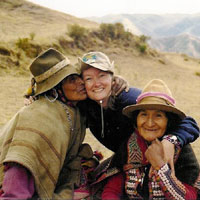An Alumna Gives Back
 My motivation to attend William & Mary can be summed up in
an image: a short, balding man with a dry sense of humor and a passion
for all things feathered—Dr. Mitchell Byrd. His mentorship became one
of the many benefits garnered in my four years at W&M.
My motivation to attend William & Mary can be summed up in
an image: a short, balding man with a dry sense of humor and a passion
for all things feathered—Dr. Mitchell Byrd. His mentorship became one
of the many benefits garnered in my four years at W&M.
At that time, the College did not have an environmental science program, so I designed an interdisciplinary major, field biology (biology, anthropology and geology), and further pursued my love for nature with a minor in studio art, focusing on biological illustration. When not studying, I joined organizations designed to address environmental issues on campus and beyond. The Biology Club, Recycling Club and Outdoors Club were well attended and quite vocal when it came to conservation issues. Collectively these organizations established the Campus Conservation Coalition (CCC) to raise awareness of the environmental challenges facing the College.
My post-graduate career began as a field biologist working for the
state’s endangered species program. I then traveled to Belize to study
neotropical migratory birds at Manomet Bird Observatory.
At the Smithsonian, I assisted in the establishment of the Smithsonian
Migratory Bird Center, which led to my study of the human dimensions of
conservation. Instead of evaluating the consequences of environmental
problems on a species-by-species basis, my focus addressed the human
actions driving environmental deterioration.
In 1993, I left the Smithsonian for Stanford University, to investigate and develop conservation plans to address a number of factors leading to the rapid decline of amphibian populations. Throughout the course of my Ph.D. work, I honed my skills in leadership development, communications, conflict resolution and other strategies to better understand and influence the human values, beliefs and actions driving environmental change. Upon completing my doctorate, I studied and was certified in Neuro-linguistic Programming (NLP) and returned to Washington, D.C., where I was a senior scientist and international policy wonk for the State Department, National Invasive Species Council and The Global Invasive Species Programme.
I realized that if we are to conserve biodiversity for future generations, we must look at environmental conservation as an art and science of motivating and empowering people. This realization inspired me to establish Ecos Systems Institute (ESI; www.ecos-systems.org) in 2003, a training company that builds the capacity of individuals and organizations dedicated to environmental conservation and sustainable development.
Attending W&M was one of the best decisions I made in my career. For that reason, it is important to me to give back to the College. I can best accomplish this by supporting students who have a passion for environmental issues, particularly those students who are eager to gain real world expertise as a complement to academic instruction.
This past summer ESI piloted a program to place such students in internships with conservation-oriented organizations in Washington, D.C. Four highly-motivated women applied and were placed at the National Council for Science and the Environment, The Environics Foundation, African Wildlife Foundation and Greenpeace.
This article appeared in the Spring 2006 issue of our newsletter, Downstream.
 Skip to main content
Skip to main content
